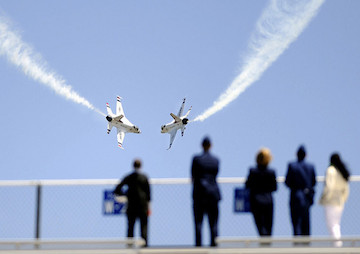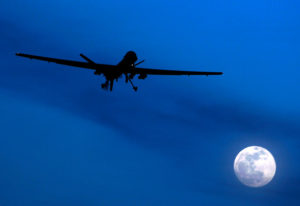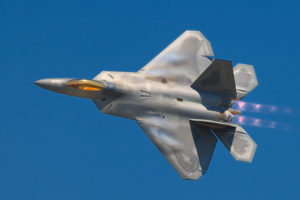Dominating the Skies — and Losing the Wars
U.S. pilots have total mastery of the fabled “high ground” of war. And yet throughout the Greater Middle East, America’s conflicts rage on with no endgame in sight. Two U.S. Air Force Thunderbirds execute a maneuver at the U.S. Air Force Academy's Falcon Stadium. (Beverly & Pack / CC-BY-2.0)
1
2
3
Two U.S. Air Force Thunderbirds execute a maneuver at the U.S. Air Force Academy's Falcon Stadium. (Beverly & Pack / CC-BY-2.0)
1
2
3
* The next round of frustration came in the country’s major conflicts in Southeast Asia in the 1960s and early 1970s. American air power bombed, strafed, and sprayed with defoliants virtually everything that moved (and much that didn’t) in Vietnam, Laos, and Cambodia. A staggering seven million tons of bombs, the equivalent in explosive yield to more than 450 Hiroshimas, were dropped in the name of defeating communism. An area equivalent in size to Massachusetts was poisoned with defoliants meant to strip cover from the dense vegetation and jungle of South Vietnam, poison that to this day brings death and disfigurement to Vietnamese. The North Vietnamese, with modest ground-fire defenses, limited surface-to-air missiles (SAMs), and a few fighter jets, were hopelessly outclassed in the air. Nonetheless, just as in Korea, widespread American bombing and air superiority, while generating plenty of death and destruction, didn’t translate into victory.
* Fast-forward 20 years to Operation Desert Shield/Desert Storm in 1990-1991, and then to the invasion of Iraq in 2003. In both cases, U.S. and coalition air forces had not just air superiority but air supremacy as each time the Iraqi air force fled or was otherwise almost instantly neutralized, along with the bulk of that country’s air defenses. Yet for all the hype that followed about “precision bombing” and “shock and awe,” no matter how air power was applied, events on the ground proved stubbornly resistant to American designs. Saddam Hussein survived Desert Storm to bedevil U.S. leaders for another dozen years. After the 2003 invasion with its infamous “mission accomplished” moment, Iraq degenerated into insurgency and civil war, aggravated by the loss of critical infrastructure like electrical generating plants, which U.S. air power had destroyed in the opening stages of the invasion. Air supremacy over Iraq led not to long-lasting victory but to an ignominious U.S. withdrawal in 2011.
Now, consider the “war on terror,” preemptively announced by George W. Bush in 2001 and still going strong 15 years later. Whether the target’s been al-Qaeda, the Taliban, al-Shabbab, al-Qaeda on the Arabian Peninsula, or more recently the Islamic State, from the beginning U.S. air power enjoyed almost historically unprecedented mastery of the skies. Yet despite this “asymmetric” advantage, despite all the bombing, missile strikes, and drone strikes, “progress” proved both “fragile” and endlessly “reversible” (to use words General David Petraeus applied to his “surges” in Iraq and Afghanistan). In fact, 12,000 or so strikes after Washington’s air war against ISIS in Syria and Iraq began in August 2014, we now know that intelligence estimates of its success had to be deliberately exaggerated by the military to support a conclusion that bombing and missile strikes were effective ways to do in the Islamic State.
So here we are, in 2016, 25 years after Desert Storm and nearly a decade after the Petraeus “surge” in Iraq that purportedly produced that missing mission accomplished moment for Washington — and U.S. air assets are again in action in Iraqi and now Syrian skies. They are, for instance, flying ground support missions for Iraqi forces as they attempt to retake Falluja, a city in al-Anbar Province that had already been “liberated” in 2004 at a high cost to U.S. ground troops and an even higher one to Iraqi civilians. Thoroughly devastated back then, Falluja has again found itself on the receiving end of American air power.
If and when Iraqi forces do retake the city, they may inherit little more than bodies and rubble, as they did in taking the city of Ramadi last December. About Ramadi, Patrick Cockburn noted last month that “more than 70% of its buildings are in ruins and the great majority of its 400,000 people are still displaced” (another way of saying, “It became necessary to destroy the town to save it”). American drones, meanwhile, continue to soar over foreign skies, assassinating various terrorist “kingpins” to little permanent effect.
Tell Me How This Ends
Here’s the “hot wash”: something’s gone terribly wrong with Washington’s soaring dreams of air power and what it can accomplish. And yet the urge to loose the planes only grows stronger among America’s political class.
Given the frustratingly indecisive results of U.S. air campaigns in these years, one might wonder why a self-professed smart guy like Ted Cruz, when still a presidential candidate, would have called for “carpet” bombing our way to victory over ISIS, and yet in these years he has been more the norm than the exception in his infatuation with air power. Everyone from Donald Trump to Barack Obama has looked to the air for the master key to victory. In 2014, even Petraeus, home from the wars, declared himself “all in” on more bombing as critical to victory (whatever that word might now mean) in Iraq. Only recently he also called for the loosing of American air power (yet again) in Afghanistan — not long after which President Obama did just that.
Even as air power keeps the U.S. military in the game, even as it shows results (terror leaders killed, weapons destroyed, oil shipments interdicted, and so on), even as it thrills politicians in Washington, that magical victory over the latest terror outfits remains elusive. That is, in part, because air power by definition never occupies ground. It can’t dig in. It can’t swim like Mao Zedong’s proverbial fish in the sea of “the people.” It can’t sustain persuasive force. Its force is always staccato and episodic.
Your support matters…Independent journalism is under threat and overshadowed by heavily funded mainstream media.
You can help level the playing field. Become a member.
Your tax-deductible contribution keeps us digging beneath the headlines to give you thought-provoking, investigative reporting and analysis that unearths what's really happening- without compromise.
Give today to support our courageous, independent journalists.





You need to be a supporter to comment.
There are currently no responses to this article.
Be the first to respond.